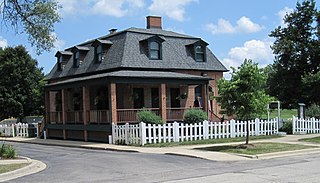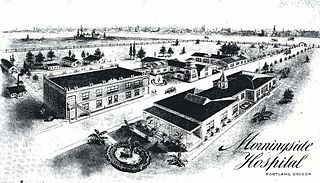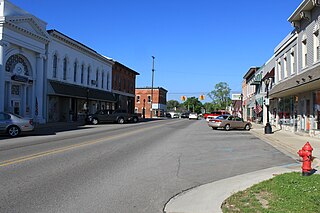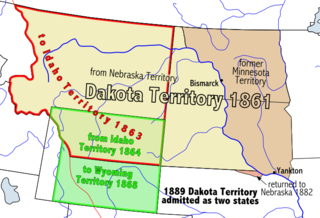
Scouting in Minnesota has a long history, from the 1910s to the present day, serving thousands of youth in programs that suit the environment in which they live.
George W. Hopkins was a lumberman involved in the removal of tens of thousands of acres of virgin forests in Michigan and Florida.

The University of Michigan Museum of Art (UMMA) in Ann Arbor, Michigan with 94,000 sq ft (8,700 m2) is one of the largest university art museums in the USA. Built as a war memorial in 1909 for the university's fallen alumni from the Civil War, Alumni Memorial Hall originally housed U-M's Alumni office along with the university's growing art collection.

The Belair Mansion, located in the historic Collington area and in Bowie, Maryland, United States, built in c. 1745, is the Georgian style plantation house of Provincial Governor of Maryland, Samuel Ogle. Later home to another Maryland governor, the mansion is listed on the National Register of Historic Places.

The Henry B. Clarke House is a Greek Revival style house in Chicago, Illinois, United States. Henry Brown Clarke was a native of New York State who had come to Chicago in 1833 with his wife, Caroline Palmer Clarke, and his family. He entered into the hardware business with William Jones and Byram King, establishing King, Jones and Company, and provided building materials to the growing Chicago populace. The house was built in circa 1836 by a local contractor, probably John Rye, who later married the Clarkes' housemaid, Betsy.

The William L. Gregg House is a historic Victorian building in the Second Empire style located in Westmont, Illinois.

Thomas Barlow Walker was a highly successful American business magnate who acquired lumber in Minnesota and California and became an art collector. Walker founded the Minneapolis Public Library. He was among the ten wealthiest men in the world in 1923. He built two company towns, one of which his son sold to become part of what is today known as Sunkist. He is the founder and namesake of the Walker Art Center.

Riversdale, is a five-part, large-scale late Georgian mansion with superior Federal interior, built between 1801 and 1807. Also known as Baltimore House, Calvert Mansion or Riversdale Mansion, it is located at 4811 Riverdale Road in Riverdale Park, Maryland, and is open to the public as a museum.

The historic village of Aurora, Cayuga County, New York, rises on a hill above the eastern shore of Cayuga Lake. The village was named by Captain Benjamin Ledyard, who settled there in 1793, in the post-Revolutionary development of the Finger Lakes region. Up until the mid-nineteenth century, Aurora played an important part in the history of Central New York.

Epreskert Art Colony was an artists' colony in Budapest in the last decades of the 19th and the first half of the 20th century. Among the artists who worked and lived there the most important were sculptors György Zala and Adolf Huszár, and painter Árpád Feszty.

Kelly's Camp is a small district of vacation cabins on the west shore of Lake McDonald in Glacier National Park, Montana, USA. Kelly's Camp consists of twelve log buildings along the western shore of the lake. The structures were notable for being one of the most extensive summer cabin enclaves remaining in the park. Early reports following the advance of the Howe Ridge Fire on August 12, 2018 are that nine or ten structures have been destroyed.

The Ivinson Mansion, now the Laramie Plains Museum, was built in 1892 in Laramie, Wyoming by Jane and Edward Ivinson. Designed by architect Walter E. Ware of Salt Lake City and built by local contractor Frank Cook, the house was regarded as the most significant residence in Laramie at its completion. Edward Ivinson gave the mansion to the Episcopal Church, which used it as a boarding school until 1958. After years of neglect, the house was acquired by the Laramie Plains Museum Association in 1972 and is used as a museum and events center.

Morningside Hospital was a psychiatric hospital in Portland, Oregon, United States. For nearly sixty years the hospital sat on a 47-acre parcel at the junction of SE Stark Street and 96th Avenue. Formerly agricultural land, the site was developed as a psychiatric hospital complex and working farm in 1910. After World War II, many of the farmers in the surrounding area retired and their land was developed into suburban communities. The rising population increased consumer demand and the under-construction interstate freeway promised easy access.

The Smith Farmhouse, also known as the Smith Homestead Farmhouse, is a historic dwelling located in Lake City, Iowa, United States. This house's significance is due to its association with the pioneer Smith family. Peter and Sarah Smith and their four young sons settled here from Cass County, Michigan in 1855. Their first two houses were built on the same property to the north of this one. Their first house and barn were log structures, and their second was frame construction. What is now known as Lake City was chosen as the county seat for Calhoun County because it was the area with the highest population. Smith donated 40 acres (16 ha) of land for the town.

The William Manatt House, also known as the Brooklyn Historical Museum, is a historic dwelling located in Brooklyn, Iowa, United States. It is associated with the settlement of the town. Manatt and his father Robert moved from Holmes County, Ohio and settled in Poweshiek County in 1848. The farmstead they developed eventually became the city of Brooklyn. His father laid out most of the town in 1855. William sold property to the Mississippi and Missouri Railroad for a $1, and it reached Brooklyn in 1862. He granted land to the Chicago, Rock Island and Pacific Railroad in 1869. Manatt owned several businesses in town, which were run by various family members, and he owned an estate that grew to 1,500 acres (610 ha) of land. He had this house built in 1869 on property that included a large barn, carriage house and pasture land. Manatt died in the house in 1906. His widow Roxann and two of his daughters, Thursia and Nellie, lived here until they died or moved out late in life. His youngest son Coe bought the house in the mid-1950s when Nellie moved out, and donated it to the city of Brooklyn before he died in 1962. It housed the Brooklyn Public Library until 1999, and since then the Brooklyn Historical Museum. The two-story frame structure features Italianate elements, especially the tall, segmentally arched windows and hooded crowns. Dental molding is found on the cornice. The porch that encircles half of the house is not original. The house was listed on the National Register of Historic Places in 1997.

The Smith-Culhane House is a private house located at 8569 Lake Street in Port Austin, Michigan. It was listed on the National Register of Historic Places in 2001. It is now operated as a bed and breakfast, the Lake Street Manor.
Trichopepla aurora is a species of stink bug in the family Pentatomidae. It is found in North America.





















